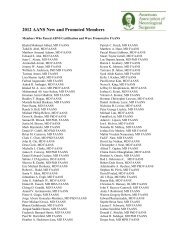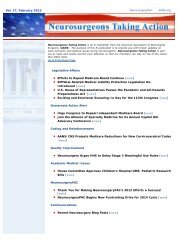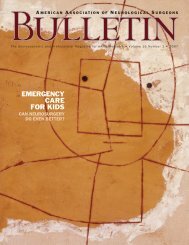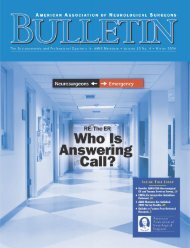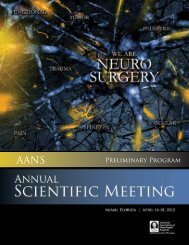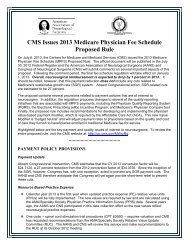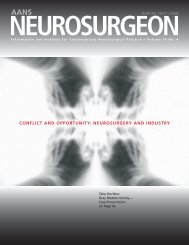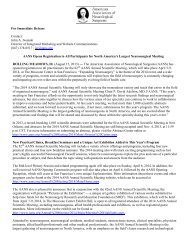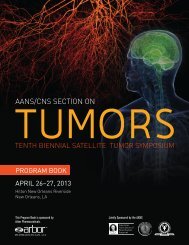view PDF - American Association of Neurological Surgeons
view PDF - American Association of Neurological Surgeons
view PDF - American Association of Neurological Surgeons
Create successful ePaper yourself
Turn your PDF publications into a flip-book with our unique Google optimized e-Paper software.
On The Cover: Time Tells<br />
ACGME-Mandated Work Hours:<br />
Implementation at the University <br />
<strong>of</strong> Oklahoma<br />
PEER-REVIEWED<br />
RESEARCH<br />
Michael D. Martin, MD<br />
University <strong>of</strong> Oklahoma<br />
College <strong>of</strong> Medicine,<br />
Department <strong>of</strong><br />
<strong>Neurological</strong> Surgery,<br />
Oklahoma City, Okla.<br />
Christopher E. Wolfla, MD<br />
Medical College <strong>of</strong><br />
Wisconsin, Department <strong>of</strong><br />
<strong>Neurological</strong> Surgery,<br />
Milwaukee, Wis.<br />
Correspondence to:<br />
M. Martin<br />
Michael-Martin@ouhsc.edu<br />
Introduction<br />
Since July 1, 2003, all residents in U.S. training programs<br />
have been required to comply with restrictions<br />
on work hours mandated by the Accreditation<br />
Council for Graduate Medical Education. Residents<br />
may work no more than 80 hours per week averaged<br />
over a four-week period. In addition, specific<br />
restrictions apply to the number <strong>of</strong> continuous<br />
hours that “in-house” and “home call” residents<br />
may spend in the hospital. These restrictions were<br />
widely debated before their implementation, and<br />
the discussion continues today (5,9).<br />
The purpose <strong>of</strong> this study was to quantify the<br />
number <strong>of</strong> times these limits were exceeded at the<br />
University <strong>of</strong> Oklahoma neurosurgery residency program<br />
since the inception <strong>of</strong> the 80-hour workweek.<br />
The study was also designed to characterize the most<br />
common reasons and situations for violations <strong>of</strong> the<br />
work hour rules. Additionally, the impact <strong>of</strong> the new<br />
work restrictions on residents’ ability to participate in<br />
surgical cases was examined.<br />
Materials and Methods<br />
The University <strong>of</strong> Oklahoma accepts one resident per<br />
year, and the program is seven years in length. The<br />
Abstract<br />
All residents in U.S. training programs are required to comply with work hour restrictions<br />
mandated by the Accreditation Council for Graduate Medical Education. The purpose <strong>of</strong><br />
this retrospective study was to quantify the number <strong>of</strong> times this limit was exceeded since<br />
its implementation on July 1, 2003, as well as to gauge the impact <strong>of</strong> restricted work hours<br />
on operative case experience <strong>of</strong> residents. Data from the University <strong>of</strong> Oklahoma resident<br />
work hour database was analyzed and incidents <strong>of</strong> violation were characterized. Operative<br />
attendance was collected from departmental records. During the study period seven violations<br />
were recorded. Further investigation revealed that all supposed violations were<br />
attributable to errors in calculation or data entry and were not truly violations <strong>of</strong><br />
ACGME-mandated rules. Residents were available to assist in more cases the year before<br />
the work hour restrictions took effect compared to the first year after they were in place.<br />
The differences were evaluated by the chi-square test and found to be significant (p <<br />
0.0001). These results suggest that limited duty hours are feasible, albeit with a decrease in<br />
operative cases in which residents take part. The impact on patient care, continuity and<br />
training experience, however, must be studied further to determine if work hour restrictions<br />
are truly in the best interest <strong>of</strong> trainees and patients.<br />
department has six residents in the second through<br />
seventh years <strong>of</strong> the program. Four residents cover<br />
the neurosurgery service, with one on elective and<br />
one in the laboratory at any given time. During the<br />
study period the department had six attending physicians.<br />
The facility, which encompasses a children’s<br />
hospital, veterans hospital, adult hospital and a level<br />
1 trauma center, has the capacity <strong>of</strong> approximately<br />
700 beds. The junior residents take call one night in<br />
four; senior residents alternate taking backup call<br />
from home one week at a time. The resident workday<br />
is 12 hours. Following call, junior residents must<br />
leave by 10 a.m., while senior residents function on a<br />
flextime system and must subtract the number <strong>of</strong><br />
extra hours they worked from the following day’s<br />
time. In other words, a senior resident who comes in<br />
at night and operates for three hours must leave three<br />
hours early the next day.<br />
For this study, a retrospective analysis <strong>of</strong> data<br />
taken from the University <strong>of</strong> Oklahoma resident<br />
work hour database was performed. The university’s<br />
data system tracks the in-hospital hours <strong>of</strong> every<br />
resident on the campus. Hours are entered daily and<br />
averages are calculated every four weeks. When a<br />
resident is found to have exceeded 80 hours, the<br />
incident is forwarded to the program director and a<br />
written explanation must be made for the violation.<br />
The data system also tracks residents by their current<br />
rotation. Our study used this data to analyze<br />
and characterize the incidents in which a violation<br />
occurred.<br />
For the second part <strong>of</strong> the study, departmental<br />
records were re<strong>view</strong>ed to assess the availability <strong>of</strong> neurosurgical<br />
residents to participate in operative cases.<br />
The department keeps these records, and their accuracy<br />
is checked in weekly meetings with all members<br />
<strong>of</strong> the resident and attending staff and then crosschecked<br />
with the online ACGME Resident Case Log<br />
System. For the purpose <strong>of</strong> this study, bedside procedures<br />
and stereotactic radiosurgery procedures were<br />
excluded. Residents are given credit for being present<br />
for part <strong>of</strong> the case, and in our internal reporting sys-<br />
14 AANS Bulletin • www.AANS.org



